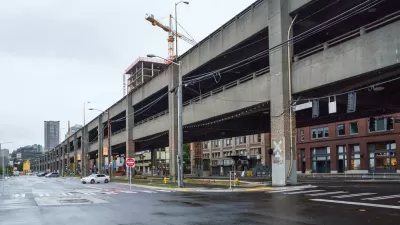San Francisco's Transbay Transit Center is just the latest example of an urban mega-project experiencing an enormous cost overrun. Eric Jaffe examines what the causes of this all too common phenomenon might be.
"So how did it get to the point where the only thing we can confidently expect from a big infrastructure project is that it will cost way more than expected?"
"One thing's for sure: the people who predict the cost of urban mega-projects do a terrible job," writes Jaffe. "Several years ago the University of Oxford scholar Bent Flyvbjerg, who's made a career researching mega-project mismanagement, analyzed 258 transportation infrastructure projects from around the world and found that nine in ten exceeded their cost estimates. The overruns were greater on rail projects than road projects but averaged 28 percent across the board."
"Whatever the underlying causes of cost overruns may be, there seems to be one promising means of addressing them: creating a 'reference class' of similar projects to serve as a platform for comparing costs. The idea, as explained by [psychologist Daniel] Kahneman in 2003 [PDF], is that old outcomes can serve as a barometer for recognizing just how unrealistic a biased new prediction might be — and help adjust it accordingly. Such a strategy controls for both political chicanery and cognitive biases alike."
FULL STORY: Why Mega-Projects End Up Costing Way More Than Expected

Manufactured Crisis: Losing the Nation’s Largest Source of Unsubsidized Affordable Housing
Manufactured housing communities have long been an affordable housing option for millions of people living in the U.S., but that affordability is disappearing rapidly. How did we get here?

Americans May Be Stuck — But Why?
Americans are moving a lot less than they once did, and that is a problem. While Yoni Applebaum, in his highly-publicized article Stuck, gets the reasons badly wrong, it's still important to ask: why are we moving so much less than before?

Using Old Oil and Gas Wells for Green Energy Storage
Penn State researchers have found that repurposing abandoned oil and gas wells for geothermal-assisted compressed-air energy storage can boost efficiency, reduce environmental risks, and support clean energy and job transitions.

Greening Oakland’s School Grounds
With help from community partners like the Trust for Public Land, Oakland Unified School District is turning barren, asphalt-covered schoolyards into vibrant, green spaces that support outdoor learning, play, and student well-being.

California Governor Suspends CEQA Reviews for Utilities in Fire Areas
Utility restoration efforts in areas affected by the January wildfires in Los Angeles will be exempt from environmental regulations to speed up the rebuilding of essential infrastructure.

Native American Communities Prepare to Lead on Environmental Stewardship
In the face of federal threats to public lands and conservation efforts, indigenous groups continue to model nature-centered conservation efforts.
Urban Design for Planners 1: Software Tools
This six-course series explores essential urban design concepts using open source software and equips planners with the tools they need to participate fully in the urban design process.
Planning for Universal Design
Learn the tools for implementing Universal Design in planning regulations.
Heyer Gruel & Associates PA
City of Moreno Valley
Institute for Housing and Urban Development Studies (IHS)
City of Grandview
Harvard GSD Executive Education
Salt Lake City
NYU Wagner Graduate School of Public Service
City of Cambridge, Maryland





























